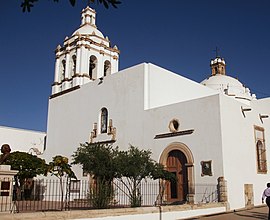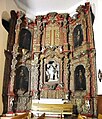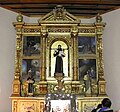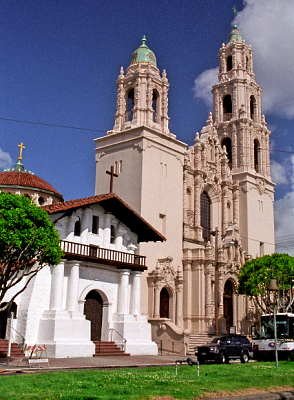
The Mission San Francisco de Asís, also known as Mission Dolores, is a historic church complex in San Francisco, California. Operated by the Roman Catholic Archdiocese of San Francisco, the complex was founded in the 18th century by Spanish Catholic missionaries. The mission contains two historic buildings:
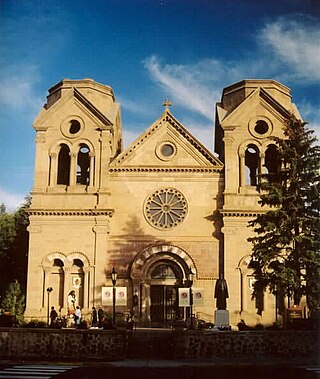
The Archdiocese of Santa Fe is a Latin Church ecclesiastical territory or diocese of the southwestern region of the United States in the state of New Mexico. While the mother church, the Cathedral Basilica of St. Francis of Assisi, is in the city of Santa Fe, its administrative center is in the city of Albuquerque. The Diocese comprises the counties of Rio Arriba, Taos, Colfax, Union, Mora, Harding, Los Alamos, Sandoval, Santa Fe, San Miguel, Quay, Bernalillo, Valencia, Socorro, Torrance, Guadalupe, De Baca, Roosevelt, and Curry. The current archbishop is John Charles Wester, who was installed on June 4, 2015.

The Cathedral Basilica of Saint Francis of Assisi, commonly known as Saint Francis Cathedral, is a Roman Catholic cathedral in downtown Santa Fe, New Mexico. It is the mother church of the Archdiocese of Santa Fe.

San Miguel Chapel, is a Spanish colonial mission church in Santa Fe, New Mexico. Originally built around 1610, it is often referred to as the oldest church in the United States. The church was rebuilt twice, once in the mid to late 17th century, and again in 1710 following the Pueblo Revolt. In both cases earlier pieces of the building may have been reused, though it is unclear to what extent. The wooden reredos, which includes a wooden statue of Saint Michael dating back to at least 1709, was added in 1798.

The Metropolitan Cathedral Church of the Holy Cross, Our Lady of Regla, and St Francis of Assisi is the main ecclesiastical building of the Catholic Church in Chihuahua City, Chihuahua, Mexico. It is considered perhaps the finest example of colonial architecture in northern Mexico and it was built between 1725 and 1792. The cathedral is also the seat of the Roman Catholic Archdiocese of Chihuahua. As of 2013 the archbishop was Constancio Miranda Weckmann.

The Franciscan missions of the Sierra Gorda of Querétaro are five missions built in Mexico between 1750 and 1760. The foundation of the missions is attributed to Junípero Serra, who also founded the most important missions in California. They were declared a World Heritage Site by UNESCO in 2003.

The Metropolitan Cathedral of the Assumption of the Most Blessed Virgin Mary into Heaven is the cathedral church of the Roman Catholic Archdiocese of Mexico. It is situated on top of the former Aztec sacred precinct near the Templo Mayor on the northern side of the Plaza de la Constitución (Zócalo) in the historic center of Mexico City. The cathedral was built in sections from 1573 to 1813 around the original church that was constructed soon after the Spanish conquest of Tenochtitlan, eventually replacing it entirely. Spanish architect Claudio de Arciniega planned the construction, drawing inspiration from Gothic cathedrals in Spain.

The Basilica of Our Lady of Zapopan and the abbey of Our lady of zapopan of Zapopan are a 17th-century Franciscan sanctuary built in downtown Zapopan, in the state of Jalisco, México.

The Royal Basilica of Saint Francis the Great is a Roman Catholic church in central Madrid, Spain, located in the neighborhood of Palacio.

The Convent of San Francisco is located at the western end of Madero Street in the historic center of Mexico City, near the Torre Latinoamericana and is all that remains of the church and monastery complex. This complex was the headquarters of the first twelve Franciscan friars headed by Martín de Valencia who came to Mexico after receiving the first authorization from the Pope to evangelize in New Spain. In the early colonial period, this was one of the largest and most influential monasteries in Mexico City. It was built on the site of where Moctezuma II’s zoo once was. At its peak, the church and monastery covered the blocks now bordered by Bolivar, Madero, Eje Central and Venustiano Carranza Streets, for a total area of 32,224 square metres.

The Ysleta Mission, located in the Ysleta del Sur Pueblo within the municipality of El Paso, Texas, is recognized as the oldest continuously operated parish in the State of Texas. The Ysleta community is also recognized as the oldest in Texas and claims to have the oldest continuously cultivated plot of land in the United States.

A capilla abierta or “open chapel” is considered to be one of the most distinct Mexican construction forms. Mostly built in the 16th century during the early colonial period, the construction was basically an apse or open presbytery containing an altar, which opened onto a large atrium or plaza. While some state that these were constructed by friars because the native peoples of that epoch were afraid to enter the dark confines of European-style churches, the more likely reasons for their construction were that they allowed the holding of Mass for enormous numbers of people and the arrangement held similarities to the teocallis or sacred precincts of pre-Hispanic temples. While open chapels can be found in other places in Spain and Peru, their systematic use in monasteries and other religious complexes, leading to a regularization of architectural elements, is only found in Mexico.

The Monastery of Saint Saviour is a Catholic Franciscan monastery located on 1 Saint Francis Street, east of the New Gate in the Old City of Jerusalem. The site was purchased from the Georgian Orthodox Church in 1560 with permission of Sultan Suleiman the Magnificent of the Ottoman Empire, and the monastery was constructed in stages. The church building was erected in 1885, with renovation in 1985. The site includes a printing press, an organ workshop, a library and a Catholic school.
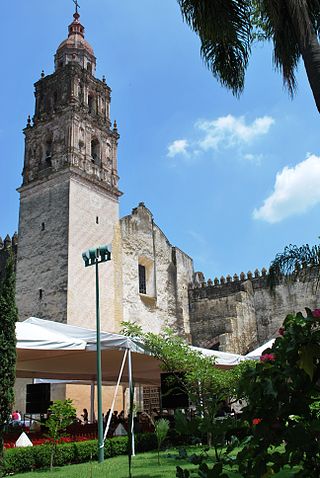
The Cuernavaca Cathedral is the Roman Catholic church of the Diocese of Cuernavaca, located in the city of Cuernavaca, Morelos, Mexico. The church and its surrounding monastery is one of the early 16th century monasteries in the vicinity of the Popocatepetl volcano inscribed as a World Heritage Site by UNESCO, built initially for evangelization efforts of indigenous people after the Spanish conquest of the Aztec Empire. By the 18th century, the church of the monastery began to function as the parish church of the city and in the late 19th century, it was elevated to the rank of a cathedral. Unlike many cathedrals in Mexico, this one does not face the city's main square, but rather is located just to the south, in its own walled compound, which it shares with a number of other structures. Unlike the other monastery structures from its time, the importance of this church provoked a number of renovation projects, the last of which occurred in 1957. This one took out the remaining older decorations of the interior and replaced them with simple modern ones. This renovation work also uncovered a 17th-century mural that covers 400 square metres (4,300 sq ft) of the interior walls and narrates the story of Philip of Jesus and twenty three other missionaries who were crucified in Japan.
The following is a timeline of the history of the city of Chihuahua, Mexico.

Sotuta Municipality (In the Yucatec Maya Language: “turning water” is one of the 106 municipalities in the Mexican state of Yucatán containing 613.15 square kilometres of land and located roughly 98 kilometres southeast of the city of Mérida.

The Immaculate Conception Cathedral, also Celaya Cathedral, is the main Catholic building in the city of Celaya in Mexico, occupying at present what was the space of a chapel annexed to the Temple of St. Francis. Because of the size of this last temple, it has come to confuse the Temple of St. Francis with the cathedral, a common mistake.

The Our Lady of Guadalupe Cathedral, also Ciudad Juárez Cathedral, is a Catholic cathedral church dedicated to the Virgin of Guadalupe that is located in Ciudad Juárez in the border state of Chihuahua, in Mexico, in the area called Historical Center. It was built in the middle of the second half of the twentieth century and is attached to the old and still preserved Franciscan mission, founded in the 17th century, in the then Paso del Norte.
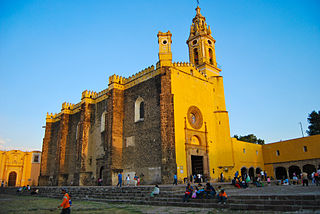
The San Gabriel Franciscan Convent or San Gabriel Friary is a church and friary in Cholula, Metropolitan area of Puebla City, Mexico.
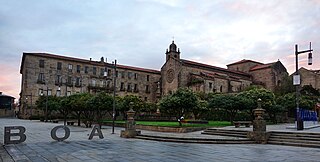
The Convent of St. Francis is a Franciscan convent located in the city centre of Pontevedra (Spain), overlooking the Plaza de la Herrería. The Gothic church of San Francis is attached to the convent on the southeast side.

